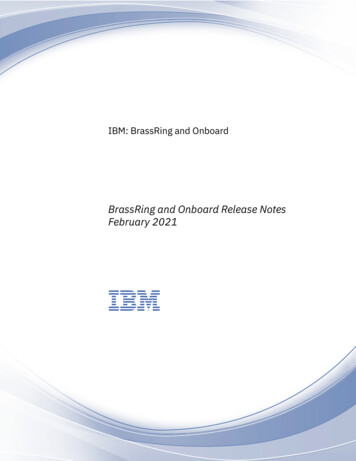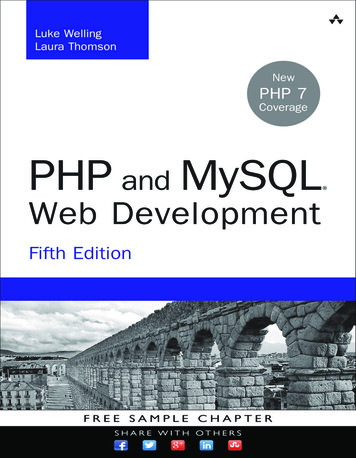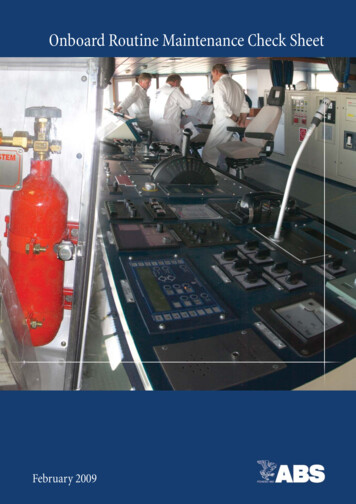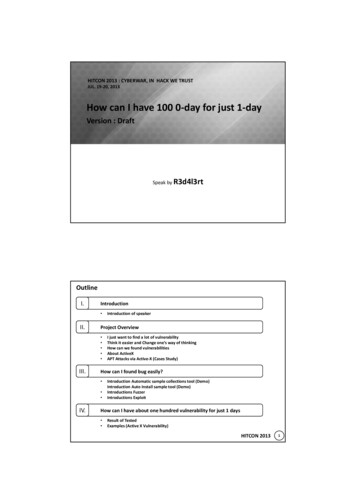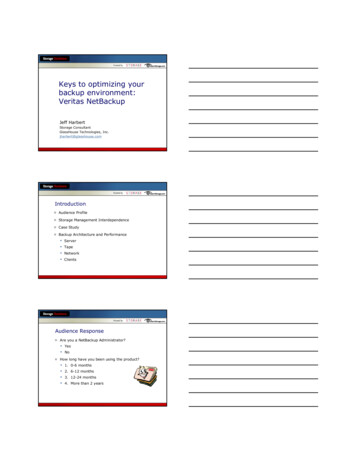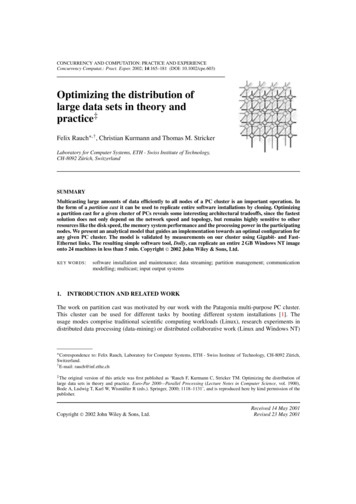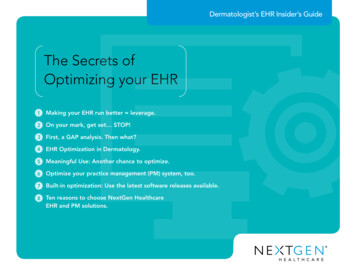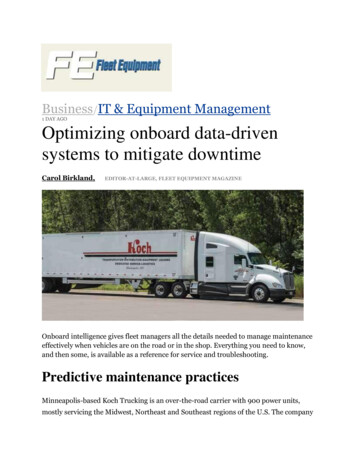
Transcription
Business/IT & Equipment Management1 DAY AGOOptimizing onboard data-drivensystems to mitigate downtimeCarol Birkland,EDITOR-AT-LARGE, FLEET EQUIPMENT MAGAZINEOnboard intelligence gives fleet managers all the details needed to manage maintenanceeffectively when vehicles are on the road or in the shop. Everything you need to know,and then some, is available as a reference for service and troubleshooting.Predictive maintenance practicesMinneapolis-based Koch Trucking is an over-the-road carrier with 900 power units,mostly servicing the Midwest, Northeast and Southeast regions of the U.S. The company
has been operating for more than 30 years and has received numerous industry awards.The fleet has been using Eaton’s IntelliConnect remote diagnostics system for threemonths. Todd Wright is the company’s director of maintenance and favors one of theprogram’s functionality features that allow him to implement predictivemaintenance practices. “When we see a code, the Eaton solution will show us a pictureof the problem, tell us what parts are bad, and will tell us if it’s a shutdown situation or acondition that can wait and the vehicle is drivable,” Wright said. “So now we canschedule any service well in advance. We can safely predict, for example, if the vehiclecan make it from Indianapolis to Pittsburgh where we can identify a dealer location forservicing. That’s what the technology is doing right now.“That same function is also allowing us to eliminate most of our costly and timeconsuming transmission inspections. If we don’t see a code pop up telling us a specifictransmission needs attention, we pretty much leave the units alone because we knowhow reliable the Eaton transmissions are.”Bobby Robinette, project team lead for connected solutions with the Eaton VehicleGroup, added that this is a software system that utilizes a fleet’s existing telematicsservice provider to get information from the truck back to Eaton for analysis.“IntelliConnect gives the fleet advanced notice that their vehicle may be having an issue,at which point they can turn a future truck-down scenario into a preventativemaintenance operation—saving them from down time, repeat warranty claims andmystery service lights,” Robinette explained. “As for access to the right information,every fleet that utilizes IntelliConnect will have the option at sign-up to have theirinformation delivered to additional monitoring systems they already use. We alsoprovide a means for the users to choose how they want to receive their notifications,whether it is in email or live in the user portal.”
Making better choicesFor Mark Gibson, president of Ashland, Oregon-based Siskiyou Transportation, it’s allabout making better choices. “At the end of the day, the ability to analyze servicehistories and costs leads to an understanding of what maintenance practices work bestin our operation,” he said. “That also leads to more effective decisions about what weneed to change.”The value in a predictive approach to vehicle maintenance for Siskiyou Transportation,according to Gibson, is magnified by the varied services the company offers. Thecompany began in 1983 as a log-hauling contractor serving southern Oregon andnorthern California. Since then, it has grown into a diversified operation providing loghauling, transfer and end-dump trucking services for aggregates and hazardous wasteand specialized transportation project consulting.For the Siskiyou Transportation fleet of 12 Class 8 logging and chip trucks, thecompany’s in-house maintenance team relies on the EROAD Service and VehicleMaintenance module. “The software greatly simplifies maintenance with its automatedservice scheduling based on any time, distance or other parameter we set,” Gibsonexplained. “It also allows us to customize inspections to meet regulatory or operatingrequirements as well as preventive maintenance items and intervals.
“The comprehensive Service and Vehicle Maintenance module allows us to proactivelymanage the maintenance and repair of our fleet,” Gibson continued. “It helps eliminatedefects that can cause delays from breakdowns or being placed out-of-service fromfailing a roadside inspection.“Maintenance and repairs are a significant component of our operating expenses,” headded. “The ability we have in the EROAD platform to plan for the future by havingaccountability and transparency around our vehicle maintenance is an essential part ofeliminating costly downtime and predictably operating successfully.”A range of solutions“Both PeopleNet and TMW Systems have a wide range of solutions aimed at improvingfleet health to decrease maintenance costs and eliminate vehicle downtime,” saidThomas Fansler, president of Trimble Transportation Mobility Analytics (the parentcompany of both TMW and PeopleNet). “The PeopleNet Mobile Gateway (PMG) is anintelligent vehicle-bridging unit that is available factory-fit or installed as an aftermarketsolution. The PMG provides a deep integration into a vehicle’s engine to give a constantview of the vehicle’s health. PeopleNet’s vehicle health monitoring technology providesautomatic notification of issues and recommends immediate actions that can prevent abreakdown or unscheduled service event.”The PMG comes factory-fit in all new Kenworth and Peterbilt trucks, and PeopleNet alsohas partnerships with several other OEMs to offer a pre-wire option on new trucks.“TMW Systems and the TMT Fleet Maintenance solutions team are now leveraging theinsight provided through PMG to help fleets identify and prioritize trucks that requireservice before they break down,” added Renaldo Adler, principal of asset maintenancefor fleets and service centers with TMW Systems. Using the Predictive Maintenancesolution in conjunction with their TMT Fleet Maintenance application, maintenancedepartments can do more than react to historical trends; they can anticipate eventsbefore they happen and schedule the work.
“The PMG isolates and communicates vehicle performance data elements representingmore than 80 engine and emissions aftertreatment variables to provide an accurate viewof vehicle health,” Adler continued. “Advanced data science is used to identify patternsthat point to a probability of failure. This information is communicated to the fleetmaintenance professional via a user dashboard in the TMT Fleet Maintenance platform.These alerts also can be communicated to fleet operations through their TMWtransportation management software so they can plan for the necessary vehicledowntime.”The new TMW predictive maintenance solution, TMT Predict.Fault Codes, wasannounced this month and will be part of a new series of applications failing under theTMT Predict brand.“The data inputs for predictive maintenance are specific to each condition that a fleet istrying to predict and prevent,” Fansler said. “For example, if a fleet is trying to detect anelevated risk of an oil pressure issue on a vehicle engine, several data inputs may berelevant including rail pressure, engine demand torque and airflow rate. The datascience team typically transforms these inputs to create the actual predictors.Additionally, the success of the predictive analytics effort will also be influenced by thegranularity of the data inputs (the frequency with which the vehicle provides updates)and latency (the time lag between data generation, data processing, and risk scoring).”Service supply chains enable predictivemaintenanceThe benefits of predictive maintenance are obvious. Being able to repair or replacecomponents just before they fail would eliminate breakdowns, reduce high costsassociated with unscheduled repairs and improve service lifecycles for fleets.“The challenge has been pinpointing with a high degree of certainty when failures willoccur,” said Michael Riemer, vice president of product and channel marketing atDecisiv. “Increasingly, we have access to a vast amount of data that allows for not onlypredicting failures, but also facilitating improvement across the entire service process.”
The right data will accelerate the move toward both predictive maintenance andproactive service, Riemer noted. “By using detailed, reliable and quality data frominternal and external service events, along with the data captured by telematics devices,we can analyze vehicle, system and component reliability to improve predictivemaintenance effectiveness,” he said.Truck and component manufacturers are already doing their part by incorporatingremote diagnostic capabilities on their vehicles. Riemer adds that there are solutionsthat fleet maintenance and outside service provider operations can use as well.Decisiv’s Service Relationship Management (SRM) platform is designed to enable theuse of actionable data to support predictive maintenance. The platform integrates withOEM and third-party diagnostic vendors to capture performance data. It also leveragesVMRS—the Vehicle Maintenance Reporting Standards, managed and licensed by theAmerican Trucking Associations—to capture the right kinds of accurate data that can beused to prescribe predictive service needs.“Service delays have a profoundly negative impact on downtime, operational efficiency,costs and, ultimately, profitability,” Riemer said. “While a true predictive maintenancecapability is still evolving, capturing reliable, quality data will enhance your decisionmaking and provide a foundation to fuel predictive analytics.”Adding diagnostics
“Typically, fleet operators look at maintenance in three ways: time-based, distancebased, or engine-hour-based,” said Dean Croke, vice president of data products atSpireon. “By adding diagnostics into the mix, we can diagnose vehicle operatingconditions that typically lead to breakdowns resulting in lost productivity. This includesanalysis of engine oil, fuel consumption, fluid level variation, operating temperatures,tire pressures and fault codes that indicate when a vehicle should be brought in formaintenance.”Scheduling maintenance based on actual vehicle health, rather than by an arbitraryschedule, helps to improve operational efficiency and keep working capital on the roads.“Our FleetLocate solution includes a variety of devices that can detect both enginediagnostics and driver behaviors, such as harsh acceleration or braking, which can affectvehicle health and performance,” Croke explained. “Our solution also integrates withGM’s OnStar system, which increases the data available for GM vehicles and alsoreduces the need to install an aftermarket device. Using the NSpire platform, whichtracks data from millions of vehicles on the road, we can apply data analytics to generateusage, health and benchmark reports across a customer’s fleet, as well as similar fleets.”Today, this information is provided as ad hoc reports, but in the future, it will beincorporated into maintenance modules and dashboards, accessible via mobile, toprovide an at-a-glance view of vehicle health and the most pressing issues that couldcause vehicle breakdowns, Croke said.“The modeling aspect of scoring vehicle data is based on probability of componentfailure, which drives the timing of when vehicles need preventative maintenance,” headded. Using the modeling data sets to allow the operator to understand aspects such astotal cost of operation, how long to keep vehicles, when to trade or sell, and whichvehicles in the fleet are underperforming.
Valuable access“We needed a solution where I could get my hands on the truck without actually flyingto the truck,” began DJ Harrison, national fleet manager for Interstate Batteries.“Geotab provided that. I could look at the engine and the transmission and never leavemy office. Before Geotab, everything was reactionary, instead of predictive. So, you’dhave to wait until something bad happened to the truck.”“Within the software, you are able to create rules based on this data to alert fleetmanagers of potential issues,” explained Stephanie Voelker, vice president of enterprisesales solutions at Geotab. “You are also able to configure maintenance reminders basedon distance and time driven.” Voelkner singled out GPS and engine data as some of themost important data collected, noting that the Geotab GO device is able to collect GPS,accelerometer and engine data such as odometer, RPM, faults, and so forth.
Pulling fault dataMark Alsbrook, Omnitracs’ senior product manager, outlined data access: “Omnitracs’extended fault monitoring product pulls the fault data from the CAN BUS on five majorECUs and sends that data to OnCommand (OCC). OCC then provides analytics such ashow severe is the fault and the recommendation action plan. They also provide historyof the faults with severity so the fleet can determine if the truck is maintained properlyor needs maintenance work. They also provide additional info such as Vehicle Reportsand location of nearest repair facility.”Some key data that can be accessed, according to Omnitracs, includes: Vehicle information—automatic vs. manual, year, model, make;Driver demographics—tenure, location, driving patterns (day vs. night), driving style(aggressive vs. passive);Load/trip information—terrain/elevation, length of haul, commodity hauled, empty vs.loaded, number of stops, rural vs. urban.Optimizing maintenance schedules“Noregon offers a variety of products and services that help fleets optimize maintenanceschedules and reduce costly repairs due to lack of insight into issues on vehicles,” saidDave Covington, Noregon’s chief technology officer. “For example, TripVision will alert
users to issues on the vehicle, in real time, and delineate the impact on the vehicle if itcontinues to operate. This information is extremely beneficial to prevent unexpectedbreakdowns or costly malfunctions, but coupled with JPRO, it helps technicians ensurethat vehicles run longer between maintenance events. When that same vehicle arrives atthe service center, a JPRO connection will access the information provided byTripVision to empower technicians to find the root cause and perform longer lastingrepairs on all components on the vehicle.”According to Covington, JPRO also provides users with a list of pending and inactivefaults. A pending fault is essentially an active fault that is unconfirmed by the time ormileage needed to register it as an active fault. A pending fault gives technicians a highlevel of certainty that the issue will fester and become a problem if not repaired. JPROalso displays the number of times a fault has become active and then inactive.This count can be a good predictor of future issues with the subsystem having theproblem. For example, coolant level problems can oscillate between active and inactivefor days before they become permanently active and cause a vehicle derate. By lookingat the count associated with the coolant faults using real-time data from TripVision, thetechnician can take action when the vehicle arrives by adding coolant or verifying thecoolant sensor’s operation to prevent an over-the-road breakdown, Covington said.Fleets seeking increased insight into their vehicles can also take advantage of Noregon’sdata analytics services. The company monitors and analyze data to detect trends aboutthe particular make/model buildup of their fleet to help find cost saving opportunitiesand relay information about common issues found across those particular vehicles.“Noregon provides all fleets and service centers with many self-paced training options toensure their technicians understand how to use all the features and functions of JPROthat help them diagnose the entire vehicle and uncover predictable issues,” Covingtonsaid. “The company ties together historical connections with all of their products todiscover trends from that particular vehicle.“For example, if a vehicle outputs an active fault in TripVision while in transit, thatvehicle will have the same information stored in JPRO during its next connection,” headded. “Noregon encourages fleets to connect JPRO to a vehicle when it initially arrives
for triage, as well as using the tool to verify the vehicle received all necessary repairs.JPRO allows for diagnosis on every module to uncover all issues on the vehicle. Nearly60% of heavy-duty vehicles still have an active fault when they leave the service center,highlighting the need to ensure completion of all repairs before the truck leaves thebay.”Tracking and E-logsRyan Driscoll, marketing director for GPS Insight, talked about the software/hardwaresupport systems the company provides and how that helps fleets develop predictivemaintenance programs for their vehicles.“GPS Insight is a tailored GPS tracking and E-Log solutions provider and within thosesolutions is a maintenance program,” he explained. “The maintenance program allowsmaintenance managers to enter in their service schedules, which can be anything fromPMs to tag expiration dates. They can also track maintenance completed and costsassociated with them and receive automated reminders in the form of text messages,emails or alerts on the GPS Insight dashboard when services are due on trucks.Maintenance managers and drivers can also receive diagnostic trouble codes when anengine issue arises and can easily schedule the truck to come in if necessary.“This helps fleets reduce the costs associated with poor maintenance and reducesdowntime, Driscoll continued. “GPS Insight’s solution is customizable so that each userreceives the information she needs, the way she wants to see it and when she needs tosee it. That way they are not overwhelmed with information that doesn’t pertain to theirjob. GPS Insight account managers can help set this up for customers to ensure that theyget the most from the data coming from their fleet.”Predictive maintenance for telematicsTo date, predictive maintenance has focused heavily on critical vehicle systems—engines, transmissions and components—with system data that is monitored by thevehicle’s electronic control monitor (ECM).
“Temperature and other key factors are monitored by the ECM, which is then reportedon through telematics devices to look for variations that could indicate eminent failure,”said Deryk Powell, president of Velociti. “Addressing potential issues before theybecome catastrophic is vital for the safety of the drivers, and will minimize vehicledowntime to maximize operational revenue.”Telematics data is used not just for relaying vehicle data, but also to log hours of service(HOS) and manage routes. Through programs like Velociti’s VelociCare, fleets arerealizing the importance of monitoring the equipment responsible for monitoring thevehicles, according to Powell.“These programs tag key parameters to look for breakdowns in communication, eitherbetween the vehicle to the device or the device to the fleet manager, or other personnelresponsible for overseeing the health of the vehicles on the road,” he explained. “Bymonitoring these key parameters, it’s possible to catch data transmission gaps thatwould lead to the loss of HOS log data, or vehicle breakdowns from late or lostwarnings.”In today’s technology-rich environment, fleets not only need predictive maintenance,they need system health monitoring to endure the programs tasked with predictingfailure haven’t themselves started to fail.“They also need a process in place to address needed repairs quickly,” Powell added.“Proactive system health monitoring avoids costly downtime due to system failure,ensures systems are operating optimally and allows them to do the job you expect ofthem. Technology providers have brought incredible solutions to our industry, and byproactively monitoring them, fleet owners can keep those solutions, and their fleets,happy and healthy with reliable and accurate predictive maintenance.”For more on advanced fleet management and predictive maintenance, read our rketvalue-lease-program/
maintenance professional via a user dashboard in the TMT Fleet Maintenance platform. These alerts also can be communicated to fleet operations through their TMW transportation management software so they can plan for the necessary vehicle downtime.” The new TMW predictive maintenance
